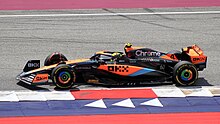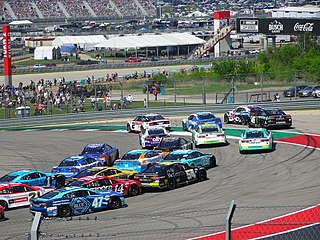
Auto racing is a motorsport involving the racing of automobiles for competition. In North America, the term is commonly used to describe all forms of automobile sport including non-racing disciplines.

Stock car racing is a form of automobile racing run on oval tracks and road courses measuring approximately 0.25 to 2.66 miles. It originally used production-model cars, hence the name "stock car", but is now run using cars specifically built for racing. It originated in the southern United States; its largest governing body is NASCAR. Its NASCAR Cup Series is the premier top-level series of professional stock car racing. Australia, Canada, New Zealand, Mexico, Brazil, Argentina, and the United Kingdom also have forms of stock car racing. Top-level races typically range between 200 and 600 miles in length.

The Indianapolis Motor Speedway is a motor racing circuit located in Speedway, Indiana, an enclave suburb of Indianapolis, Indiana. It is the home of the Indianapolis 500 and the Brickyard 400 and formerly the home of the United States Grand Prix and Indianapolis motorcycle Grand Prix. It is located six miles (9.7 km) west of Downtown Indianapolis.
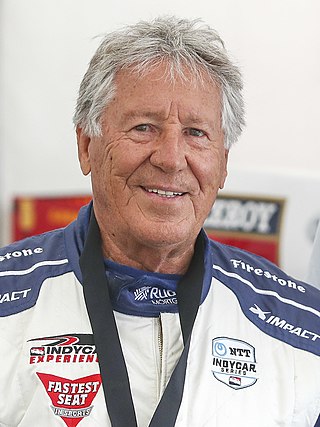
Mario Gabriele Andretti is an American former racing driver. He is widely regarded among the most successful drivers in the history of motorsports. Andretti is one of only three drivers to have won races in Formula One, IndyCar, the World Sportscar Championship, and NASCAR. He has also won races in midget car racing and sprint car racing.
Motorsport(s) or motor sport(s) are sporting events, competitions and related activities that primarily involve the use of automobiles, motorcycles, motorboats and powered aircraft. For each of these vehicle types, the more specific terms automobile sport, motorcycle sport, power boating and air sports may be used commonly, or officially by organisers and governing bodies.

Daniel Sexton Gurney was an American racing driver, race car constructor, and team owner who reached racing's highest levels starting in 1958. Gurney won races in the Formula One, Indy Car, NASCAR, Can-Am, and Trans-Am Series. Gurney is the first of three drivers to have won races in sports cars (1958), Formula One (1962), NASCAR (1963), and Indy cars (1967), the other two being Mario Andretti and Juan Pablo Montoya.

Edward McKayCheever Jr. is an American former racing driver who raced for almost 30 years in Formula One, sports cars, CART, and the Indy Racing League. Cheever participated in 143 Formula One World Championship races and started 132, more than any other American, driving for nine different teams from 1978 through 1989. In 1996, he formed his own IRL team, Team Cheever, and won the 1998 Indianapolis 500 as both owner and driver. The team later competed in sports cars.

In motorsports, a pit stop is a pause for refuelling, new tyres, repairs, mechanical adjustments, a driver change, as a penalty, or any combination of the above. These stops occur in an area called the pits, most commonly accessed via a pit lane which runs parallel to the start/finish straightaway of the track and is connected to it at each end. Along this lane is a row of garages outside which the work is done in a pit box. Pit stop work is carried out by the pit crew of up to twenty mechanics, depending on the series regulations, while the driver often waits in the vehicle.

The Monza Circuit is a 5.793 km (3.600 mi) race track near the city of Monza, north of Milan, in Italy. Built in 1922, it was the world's third purpose-built motor racing circuit after Brooklands and Indianapolis and the oldest in mainland Europe. The circuit's biggest event is the Italian Grand Prix. With the exception of the 1980 running when the track was closed while undergoing refurbishment, the race has been hosted there since 1949.

Michele Alboreto was an Italian racing driver. He was runner-up to Alain Prost in the 1985 Formula One World Championship, as well as the winner of the 1997 24 Hours of Le Mans and the 2001 12 Hours of Sebring sports car races. Alboreto competed in Formula One from 1981 until 1994, racing for a number of teams, including five seasons (1984–88) for Ferrari.
Teodorico Fabi is an Italian former racing driver. He competed in Formula One, IndyCar, and sports car racing. He claimed pole position in his rookie year at the 1983 Indianapolis 500. Teo is the older brother of former Formula One driver Corrado Fabi.
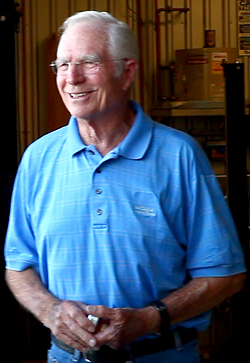
James Ellis Hall is a retired American racing driver, race car constructor, and team owner. While he is best known as a car constructor, he was one of the greatest American racing drivers of his generation, capturing consecutive United States Road Racing Championships, two Road America 500s, two Watkins Glen Grands Prix for sports cars, the 1965 Canadian Grand Prix for sports cars, the 1965 Pacific Northwest Grand Prix, and scoring a massive upset at the 1965 12 Hours of Sebring over a contingent of factory-backed Ford GTs, Shelby Daytona Coupes, and Ferrari entries. If anything Hall's accomplishments behind the wheel have been overshadowed by his pivotal contributions to race car design through his series of Chaparral sports racing and Indy cars. Hall's cars won in every series in which they competed: USRRC, Can-Am, Trans-Am, Formula 5000, World Sportscar Championship, Autoweek Championship, Canadian Sports Car Championship, and the Indianapolis 500.
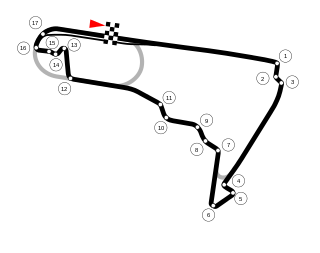
The Autódromo Hermanos Rodríguez is a 4.304 km (2.674 mi) motorsport race track in Mexico City, Mexico, named after the racing drivers Ricardo Rodríguez (1942–1962) and Pedro Rodríguez (1940–1971). The circuit got its name shortly after it opened when Ricardo Rodríguez died in practice for the non-Championship 1962 Mexican Grand Prix. Ricardo's brother Pedro was also killed behind the wheel nine years later. Since 2015, the track has once again hosted the Formula One Mexican Grand Prix, an event it previously hosted in two separate periods on a different layout, the last occasion of which was in 1992.

Formula Mazda is a class of relatively affordable open-wheel car formula racing.
In motorsport, the fastest lap is the quickest lap run during a race. Some racing series, like Formula One, Formula 2 and Formula E award championship points for a driver or team that set the fastest lap.
David Martínez is a Mexican racing driver. He holds the record for the best debut ever by a Mexican driver in a premiere open-wheel series with his 9th place finish at the 2006 Gran Premio Telmex.

Mikhail Petrovich Aleshin is a Russian professional racing driver and the 2010 champion of the Formula Renault 3.5 Series.
The following is a glossary of terminology used in motorsport, along with explanations of their meanings.

The 1976 Los Angeles Times 500 was a NASCAR Winston Cup Series race that took place on November 21, 1976, at Ontario Motor Speedway in Ontario, California. Each copy of the souvenir program was $2.

The FIA Formula 3 Championship is a third-tier international single-seater racing championship and organised by the Fédération Internationale de l'Automobile (FIA). The championship launched in 2019 as a feeder series for the FIA Formula 1 World Championship and FIA Formula 2 Championships. It was the result of a merger between two third-tier single-seater racing championships, the GP3 Series and the FIA Formula 3 European Championship as it was announced on 10 March 2018. The championship is part of the FIA Global Pathway consolidation project plan. Unlike its predecessor, the Formula 3 European Championship, the series runs exclusively in support of Formula One races.
